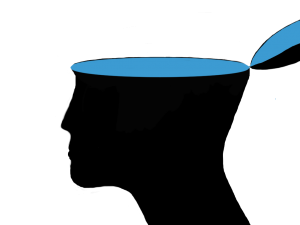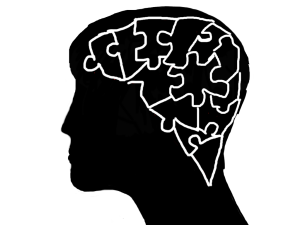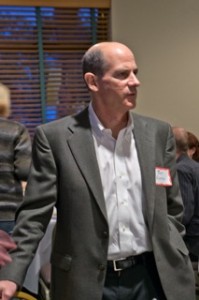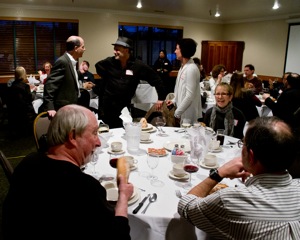Whose brain is it?
by Leena Prasad
Presented within the flow of the lives of fictional characters, this is a monthly column with a journalist’s perspective on brain research.
I catch a glimpse of rice and mackerel. She is holding a small piece in-between her thumb and index finger. That’s the authentic way of eating sushi, instead of using chopsticks, I think.
 But something else happens in my mind also. My friend and I have just been seated at the Japanese restaurant and have not even looked at the menu. Yet I can almost taste the saba (rice and mackerel) and memories of the sour salty taste make my mouth water. I recall a class lecture from my neuroscience class about mirror neurons.
But something else happens in my mind also. My friend and I have just been seated at the Japanese restaurant and have not even looked at the menu. Yet I can almost taste the saba (rice and mackerel) and memories of the sour salty taste make my mouth water. I recall a class lecture from my neuroscience class about mirror neurons.
I am not in the medical profession but studied artificial intelligence as part of my computer science curriculum and later worked in the field. This led to an interest in neuroscience. I use my graduate school training as a journalist to research and explore the brain using what I learned in the introductory neuroscience class as a basic foundation for my journey.
But, this is not a story about me or about sushi. It’s about specific neurons in my brain and in yours – nerve cells that help us connect to each other’s experiences. These neurons are helping to answer questions ranging from feeling hungry while watching someone else eat to feeling the pain of another person to the excitement felt by sport audiences, to learning by watching someone do something.
When I see the saba, the occipital lobe in the back of the brain, processes the visual information. The hippocampus and other parts of the brain retrieve the memory of my own experiences with saba. When I eat the sushi, neurons in the premotor cortex, in the frontal lobe of the brain, enable me to use my fingers to pick up the sushi, bring it to my mouth, and to eat it. Every single action, from the details of the movement of my arms and fingers to the complexities of biting and chewing are handled by the premotor nerve cells.
 But if I am not eating the rice and mackerel myself, how is it that my mouth waters as if I can taste the sushi?
But if I am not eating the rice and mackerel myself, how is it that my mouth waters as if I can taste the sushi?
As human beings, most of us (excluding people with autism and other brain related diseases) understand empathy. Now, neuroscientists are exploring the coding of empathy within our brain. They have discovered nerve cells which mirror the actions of other people as if we are experiencing what we see. These neurons reside in the premotor cortex along with the premotor neurons which cause motor reflexes. Mirror neurons are a special subset of the premotor neurons and they fire whether we perform an action ourselves or watch others perform the action.
Mirror neurons were discovered by researchers in Parma, Italy in 1992. The scientists had placed electrodes in the brain of a monkey to record and study nerve cell activity by amplifying the sounds made inside the brain when a neuron fires. By chance, they heard the same set of premotor neurons fire off both when the monkey was picking up a peanut and also when the monkey was just watching someone else pick up a peanut. Similar experiments were repeated in monkeys and humans by several follow-up studies conducted by the scientists at Parma and by other scientists around the world.
“I predict that mirror neurons will do for psychology what DNA did for biology,” says Dr. Vilayanur Subramanian Ramachandran, a Professor in the Department of Psychology and the Neurosciences Graduate Program at the University of California, San Diego. In a recent TED lecture entitled “The neurons that shaped civilization” Dr. Ramachandran theorizes that a lot of human learning, and thus evolution, probably speeded up due to mirror neurons.
There are two types of mirror neurons, according to Dr. Christian Keysers, a Professor at Netherlands’ largest medical faculty, the University Medical Center in Groningen. The two types are: strictly congruent and broadly congruent. The strictly congruent neurons are activated for very specific familiar actions. So, when I watch someone eat saba or eat it myself, I’m using strictly congruent neurons. The broadly congruent neurons are activated for actions that might be unfamiliar to me. For example, if I start taking classes in auto repair, I would be using broadly congruent neurons since I do not know much about this topic.
This is an exciting discovery. I found many articles and books and videos on the topic. A lot of the current research is speculation and excitement with a smattering of data to backup the assertions. There are ongoing discussions and experiments to locate mirror neurons in other parts of the brain, in addition to those in the premotor cortex. This trendy subject has been used to explain a range of behavioral phenomena such as language learning, empathy, and lack of emotional intelligence in autism. I look forward to learning more about these neurons as scientists gather more data and develop theories on how the knowledge can be used to understand and fine-tune human behavior. For now, at least I understand why I can taste the sushi by just looking at someone else put it in her mouth.
Please send feedback and suggestions for future columns to leena@fishridingabike.com. Go to WhoseBrainIsIt.com for links to past columns and to FishRidingABike.com for Leena’s writing portfolio. Leena has a journalism degree from Stanford University.
Dr. Nicola Wolfe is a neuroscience consultant for this column. She earned her Ph.D. in Clinical Psychopharmacology from Harvard University and has taught neuroscience courses for over 20 years at various universities.
References:
Ramachandran. Vilayanur Subramanian. Ph.D. The neurons that shaped civilization: VS Ramachandran. TED Talk, January 4, 2010
Keysers, Christian, Ph.D. The Empathic Brain. Social Brain Press, 2011


